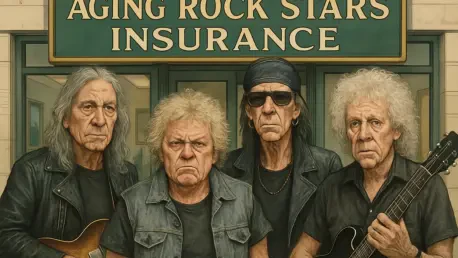The recent passing of Ozzy Osbourne at 76 has drawn significant attention not only to his legendary contributions to heavy metal but also to the challenges faced by insurers tasked with covering aging rock stars. As these icons continue to engage in demanding tour schedules, their advancing years and health issues present a unique problem for the insurance industry. Insuring older performers, particularly those who have battled significant health problems, involves a degree of uncertainty that makes risk assessment and premium pricing exceedingly difficult. This complex landscape is emblematic of a broader industry trend where insurers must balance the potential for costly claims against the allure and profitability of insuring performers whose careers have spanned decades. As the demand for the legendary acts of yesteryears remains strong, the insurance market finds itself tasked with developing nuanced solutions that address the risks while supporting the ongoing viability of their careers. In exploring the complexities of insuring aging rock stars, the industry’s dedication to innovation and adaptability is tested like never before.
Challenges in Insuring Aging Icons
The task of underwriting policies for rock stars like Osbourne is fraught with complications, largely due to the health issues that accompany aging. Osbourne’s health struggles, including Parkinson’s disease and spinal problems, serve as a textbook example of the unpredictable nature of insuring older performers. Each medical condition introduces new variables to the risk equation, making it difficult for insurers to accurately predict or price potential claims. This unpredictability is further compounded by the intrinsic risk involved in the high-energy performances typical of rock concerts. As such, insurers must not only consider a performer’s medical history but also the physical demands of their performance schedules when creating policies. This amalgamation of variables has necessitated a recalibration in the approach taken by insurers when dealing with older artists, spotlighting the industry’s need to evolve in response to these unique challenges.
Underlying these challenges is the critical question of how to appropriately price insurance policies for performers when the artists themselves embody the greatest risk factor. Traditional actuarial models often fall short, unable to accommodate the idiosyncrasies of individual artists whose lifestyles and health conditions defy standard statistical categories. The costs associated with crafting insurance for these all-encompassing risks have pushed many policies into a costly echelon, making insuring older rock stars a premium investment. This high-cost backdrop has led to alternative approaches such as self-insurance among financially stable performers who might favor controlling their liabilities over paying exorbitant premiums. However, less affluent artists or those with precarious financial standings may not have this luxury, pushing them to accept restrictive and expensive policy terms or risk financial instability. This dynamic has become a significant talking point within the industry, where stakeholders must rethink how to meet insurance needs effectively.
High Costs and Industry Responses
The evolution of non-appearance insurance, previously a standard aspect of tour planning, highlights another dimension of the increased financial demands linked to insuring older artists. Once a predictable part of business models, non-appearance insurance has morphed into a niche product characterized by higher costs and more restrictive terms. For younger artists, these policies might represent just a small slice of overall tour expenses, but the inverse is true for legacy performers. For stars like Ozzy Osbourne, premiums can soar as high as 15% of total show fees. Given the multimillion-dollar payouts involved in major tours, these risky investments in non-appearance insurance have prompted artists and their management teams to explore insurance alternatives. The escalation in premium costs within this specific insurance sector underscores the broader trend of fiscal prudence driving change across the board in how artists and their teams handle potential financial setbacks.
The increased interest in self-insurance is another significant development within this changing landscape, serving as a viable option for well-established artists with substantial financial reserves. Where the balance tips toward premiums outweighing potential claims or policy stipulations feeling too confining, self-insuring may provide the flexibility performers seek. While this approach allows artists to assume full control over their liabilities, the financial safety net is not universally applicable, as it excludes artists without the necessary resources to support such a strategy. For many, a single tour cancellation without insurance could spell economic catastrophe. As more successful performers pivot towards self-insurance, younger and less financially stable acts may find themselves navigating increasingly restricted options, illustrating the divide between those who can capitalize on their legacies and those still building their reputations.
Industry Innovation and Future Prospects
Recent years have highlighted the shifting insurance landscape surrounding performers who not only draw large crowds but are key cultural figures synonymous with entire musical eras. The need for industry-wide adaptations has never been more pressing as major artists like Mick Jagger and Paul McCartney continue to attract massive audiences well into their seventies and eighties, adding to the nuanced dynamics insurers must navigate. Current policies must account not only for the escalating health concerns correlated with age but also for the complexities involved in logistics required for global tours. These logistical challenges escalate with age, creating additional considerations in constructing comprehensive and effective insurance policies. As the industry seeks proactive solutions, insurers are prompted to develop coverage options flexible enough to accommodate both the inherent unpredictability of live events and the evolving demands of aging performers seeking to continue their illustrious careers.
The enduring popularity of aging performers encourages insurers to foster innovation, crafting flexible insurance policies that balance profitability with practicality. The process is driven by the benefits of engaging legendary artists whose influence remains unmatched. While underwriting older artists bears its unique challenges, insurers are aware of these performers’ unique appeal, pushing them to develop solutions even amid unpredictable risks. Simplified policy offerings and adapted contract terms could form the basis of a renewed partnership between insurers and performers, driven by shared interests in maintaining commercially viable performances without compromising health considerations. This collaborative approach isn’t solely reliant on fiscal dynamics; it represents an opportunity to capture both performers’ and insurers’ willingness to embrace the inevitable changes within the evolving insurance landscape.
Comprehensive Strategies and Sustainable Futures
The recent passing of Ozzy Osbourne at 76 has highlighted not only his monumental influence on heavy metal but also the hurdles faced by insurers covering aging rock stars. As these legendary performers persist in intense tour schedules despite their advancing years, health issues pose challenges for the insurance sector. Insuring older artists, especially those who’ve encountered significant health struggles, breeds uncertainty, complicating risk assessment and premium pricing. This situation reflects a broader industry trend where insurers navigate the delicate balance between costly claims and the benefits of covering performers whose careers span decades. The consistent demand for iconic acts underscores the insurance market’s task in crafting sophisticated solutions that manage risks while ensuring the continued viability of these artists’ careers. Addressing the intricacies of insuring aging rock stars showcases the industry’s commitment to innovation and adaptability, testing it in ways never seen before.









